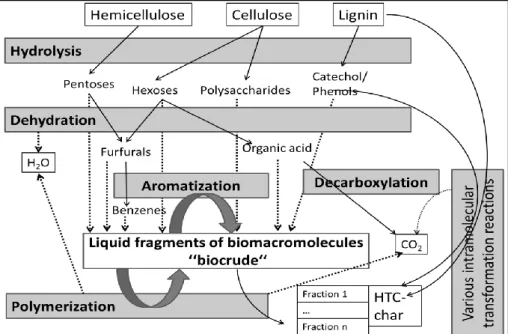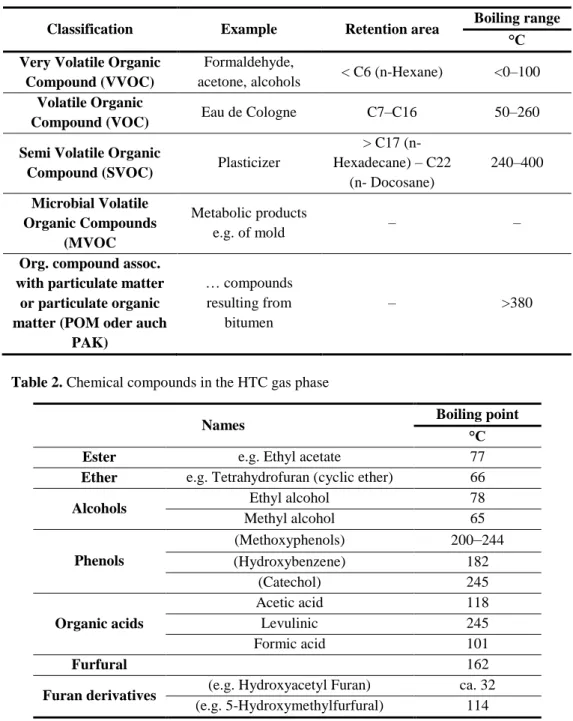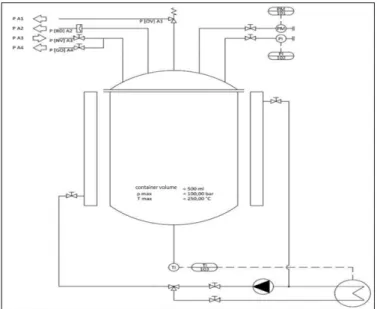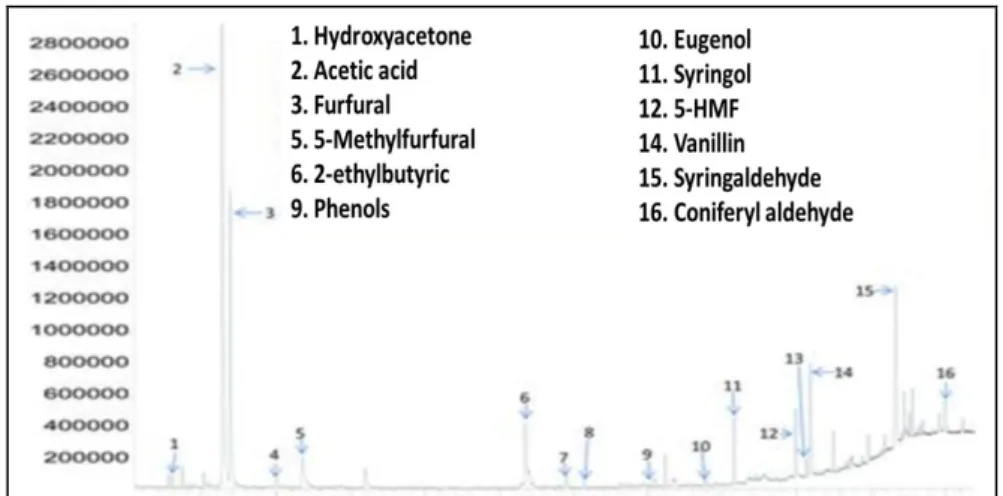HYDROTHERMAL CARBONIZATION PROCESSES
TO INCREASE THE TRANSPORTABILITY OF PLANT
BIOMASSES
Mathias Schlegel
1, Bassel Ibrahim
2, Jozef Fras
3, Norbert Kanswohl
4and Jens Zosel
51
University of Rostock, Faculty of Agriculture and Environmental Sciences, 18059 Rostock, Justus-von-Liebig-Weg 6b, Germany, E-mail: mathias.schlegel@uni-rostock.de 2 Innovation and Education Center e.V. Hohen Luckow, 18239 Hohen Luckow, Bützower
Str. 1a, Germany, E-mail: bassel.ibrahim@ibz-hl.de
3 Faculty of Engineering Management, Poznan University of Technology, Strzelecka 11, 60-965, Poznan, Poland, E-mail: jozef.fras@put.poznan.pl
4 University of Rostock, Faculty of Agriculture and Environmental Sciences, 18059 Rostock, Justus-von-Liebig-Weg 6b, Germany, E-mail: norbert.kanswohl@uni-rostock.de
5 Kurt-Schwabe-Institute for Measuring and Sensor Technology e.V., 04736 Waldheim, Kurt-Schwabe-Str. 4, Germany, E-mail: zosel@ksi-meinsberg.de
Abstract: Plant biomasses often have high water content and their energy and material density is too
low, which significantly affects their high transport costs. Hydrothermal carbonization is a suitable method to increase the transportability of these biomasses. The produced biochar (HTC-char) is rich in carbon. Disadvantages of such carbonization process are the quality fluctuations of the biochars produced. This is also because there are to date no suitable measuring methods for the carbonization process. The paper presents a novel method, which will help to influence the carbonization process in the sense of qualitatively equivalent biochars by means of the achievable data therewith.
Paper type: Research Paper Published online: 30 April 2018 Vol. 8, No. 2, pp. 169–178
DOI: 10.21008/j.2083-4950.2018.8.2.4 ISSN 2083-4942 (Print)
ISSN 2083-4950 (Online)
© 2018 Poznan University of Technology. All rights reserved.
Keywords: transportability, plant biomasses, process
1. BIOMASS AS RAW MATERIAL FOR
THE MATERIAL-TYPE USE
The coal we now use mainly as a fuel was produced in the era of the Carboniferous. Dead woody biomass was first affected by microbiological and then by tectonic processes. The latter caused very high pressures and temperatures. That reduced greatly the proportion of oxygen and hydrogen – main components of plant water – in the biomass. The carbon content increased as a result, the resulted compound being coal. A higher energetic density than the raw material character-rizes the generated coal. This makes it significantly more attractively to transport coal instead of wood (Hoekman, Broch & Robbins, 2011).
Biomass accumulated today, e.g. kitchen residues, agricultural or communal organic residues, landscaping materials, etc., are not unlike the dead biomass of the Carboniferous. They also contain a lot of water, which means that the carbon we are interested in is found in a dilution. Again, here we have the same case as mentioned before, in which the low carbon density makes the transport of these biomasses in particular less profitable. In addition to the well-known use as a fuel, a higher transportability – in the form of coal – would lead to further interesting utilization options (Titrici & Thomas, 2007; Tropsch & Phillipovich, 1922). Among these, their use as adsorbers is highly interesting. Since, when phosphorus, nitrogen or sulfur is adsorbed with the HTC-char, it can serve with this charging as a basic component for Terra Preta (Glaser, Haumaier, Guggenberger & Zech, 2001).
In order to increase the transportability, a technically promoted form of thermochemical influencing, especially known as hydrothermal carbonization (HTC) can be useful as an imitation of the natural process described above.
Two essential aspects characterize the HTC, which is carried out in a pressure-tight reactor. Firstly, a high temperature (approx. 180– approx. 250°C) is set, which in turn affects the pressure in the reactor (approx. 10–40 bar), the latter is determined essentially by the evaporation of the plant water and/or the additionally added process water. The second aspect, which results partly and indirectly from the first-mentioned aspect, consists in the possibility of using wet biomasses.
The possibility of using wet biomasses as a raw material distinguishes this process from another important thermochemical treatment, the pyrolysis. With it, only drier lignocellulose-containing biomasses can be carbonized. The process
equipment is not as complicated with the pyrolysis as with the HTC, but the production of a HTC-char with the desired quality is faster under HTC (Hoekman, Broch & Robbins, 2011).
2. HYDROTHERMAL CARBONIZATION FOR THE UPGRADING
OF PLANT BIOMASSES
Plant biomass consists of different components. In addition to fats and proteins, a large number of hydrocarbons are found. Among the latter is the so-called lignocellulose, which can be subdivided into hemicellulose, cellulose and lignin. These components have different distributions in different plants. Such variations are also detectable within a plant, which makes the starting biomass very heterogeneous in general.
Under the process conditions of the HTC, the individual lignocellulose compo-nents are converted at different rates (Fig. 1). The hemicellulose is decomposed rather than the lignin due to its internal structure. Residues of the more stable ingredients always remain, with exactly these structures representing the desired carbon base body of the biochar.
Fig. 1. Schematic of relevant reaction mechanisms of hydrothermal carbonization (Funke, 2012)
This carbon base body can be qualitatively described with the pore number and size, the atomic carbon-oxygen ratio and the yield as well as other parameters. The state, which can be defined with these parameters, is determined by the starting biomass (composition of the lignocellulose) on the one hand and, on the other hand, by the process conditions – In particular temperature, pressure and holding time.
Prior to the carbonization, the composition of the raw material used, in particular the dry matter must firstly be estimated or analyzed. These and other values are necessary for the initial settings of temperature, pressure, holding time and other process parameters. The station operator has been guided by preliminary investigations into lignocellulose and by the experience he has gained in previous carbonization processes.
3. BIOCHAR QUALITY
The final quality of the biochar produced can only be assessed after the completion of the carbonization process. Each carbonization process leads to different biochar qualities due to the above-mentioned heterogeneity of the raw biomass and its interaction with the process conditions. This variation has a very disadvantageous effect when the biochar produced is to be used as a functional material, for example as a filler for elastomers and plastics (Autorenkollektiv, 2017).
The problem is therefore the difficulty of producing a biochar with a consistent high quality (Rödger, Loewen & Shackley, 2012). This is the basis for the aim of a planned research project in order to develop process engineering or technical solutions for the production of widely consistent biochar qualities. In particular, it must be determined in which process phase particularly relevant information about the expected quality of the biochar can be obtained. Above all, the temporal pathways of the concentrations of essential starting and final products of the reactions described in Figure 1 can provide such information. Due to the high tempe-ratures and pressures in the HTC reactor, in-line measurements of these parameters are not possible, so the process runs in a black box. However, it is possible to take samples from the process and to analyze them, whereby the phases described in the following are available.
Liquid phase: In the reactor and at the beginning of the process, the biomass to be converted is completely surrounded by process water. So that the heat supplied is distributed homogeneously and more quickly in the reactor. When high tempe-ratures are reached and the reactions shown in Figure 1 occur, various reaction products can be found in the HTC slurry. These are, for example, oligomeric and monomeric sugars, furfural, 5-hydroxymethyl, -2-furaldehyde (HMF), organic acids such as acetic, levulinic, formic and lactic acids, phenols etc. (Stemann, 2013). Gaseous phase: According to Raoult's law, the process products contained in the HTC slurry partly pass into the gaseous headspace, so that we can use this
property for the process monitoring. This transition does not concern the high-boiling components, such as glucose or xylose, but their degradation products or the intermediates resulting therefrom, which are in the gaseous state. These compounds can be analytically evaluated in the condensates that can be extracted therefrom.
The HTC slurry can be relatively easily removed, as a liquid phase, via valves from the HTC reactor. One example with a corresponding technical removal device could be found in the literature of Fraunhofer Institute for Solar Energy Systems reactors. However, the significant heterogeneity of the HTC slurry has a negative effect, which requires a separation of solid and liquid phases before analytical investigations by means of HPLC or GC. This necessary sample pretreatment (for example, by solid-liquid separation, centrifugation, etc.) leads on the one hand in time delays and, on the other hand, to changes in concentration due to the adsorption or the outgassing, which can seriously impair a reliable process monito-ring of the HTC. Indeed, no complex pre-treatment is necessary for the analysis of the gaseous phase; but it has the disadvantage that not all of the present products of the different sub-processes can be detected.
The project idea is therefore the online analysis of the gas phase present under the given temperature and pressure conditions as headspace in order to obtain informa-tion on the current process state in the HTC slurry, especially the biochar contained therein. It is to be assumed that, for example, a composition with a lot of hemicel-lulose and little lignin produces a characteristic pattern of volatile decomposition products upon their degradation, which differs, for example, from the pattern of volatile decomposition products when there is a lot of lignin and little hemicel-lulose (Autorenkollektiv, 2017). From this, outgoing correlations between the decomposition product pattern and the biochar quality can be established. In this way, the circle is closed between the existing investigation of the starting biomass relating to the composition before the carbonization process on the one hand and the expected biochar quality under certain process conditions (temperature, pressure and plateau time) on the other hand (Schlegel & Ibrahim, 2016).
4. VOLATILE SUBSTANCES OF THE GAS PHASE WITHIN
THE HTC PROCESS
Belonging to the volatile organic compounds (Total Volatile Organic Compounds; TVOC) which are accessible to analysis, include the compounds listed in Table 1, which evaporate or volatilize due to their vapor pressure or low boiling point (Lide).
Hereinafter, some chemical compounds are listed as examples found in the gas phase of HTC processes. Information about the relationships between these com-pounds and their precursor substances in the liquid phase will be of great use for
the understanding of HTC processes, so that in a planned research project, their complete analytical explanation must be provided first.
Table 1. Volatile Organic Compounds (Total Volatile Organic Compounds, TOC) (www1; www2)
Classification Example Retention area Boiling range °C Very Volatile Organic
Compound (VVOC)
Formaldehyde,
acetone, alcohols < C6 (n-Hexane) <0–100 Volatile Organic
Compound (VOC) Eau de Cologne C7–C16 50–260 Semi Volatile Organic
Compound (SVOC) Plasticizer
> C17 (n-Hexadecane) – C22 (n- Docosane) 240–400 Microbial Volatile Organic Compounds (MVOC Metabolic products e.g. of mold – – Org. compound assoc.
with particulate matter or particulate organic matter (POM oder auch
PAK)
… compounds resulting from
bitumen
– >380
Table 2. Chemical compounds in the HTC gas phase
Names Boiling point
°C
Ester e.g. Ethyl acetate 77
Ether e.g. Tetrahydrofuran (cyclic ether) 66
Alcohols Ethyl alcohol 78
Methyl alcohol 65 Phenols (Methoxyphenols) 200–244 (Hydroxybenzene) 182 (Catechol) 245 Organic acids Acetic acid 118 Levulinic 245 Formic acid 101 Furfural 162
Furan derivatives (e.g. Hydroxyacetyl Furan) ca. 32 (e.g. 5-Hydroxymethylfurfural) 114
5. REACTOR DESIGN
Up to now, i.a. flow reactors, batch autoclaves and technical solutions that can be assigned to both groups are known.
Fig. 2. Technical drawing of a laboratory reactor for hydrothermal carbonization (www3)
The design of batch autoclaves according to Figure 2 is particularly suitable for the for the ongoing aim of the planned research project to remove gas mixtures from the headspace of HTC reactors, since it offers the possibility of reliable valve-controlled automatic removal of gas mixtures with the volatile compounds contained therein. The batch autoclave is an example because it is possible to use the principle of measurement in other configurations like plug-flow reactors and so forth. In fact other devices are necessary but a removal of gaseous phase to get conclusions about the process state is feasible.
6. GAS PHASE USE FOR ANALYSIS
After releasing and cooling of removed gaseous analytes they condense in an aqueous solution at temperatures between zero and 20 °C and normal pressure. This condensate can be analyzed by chromatographic, spectroscopic and photo-metric methods.
As an example, Figure 3 shows a chromatogram of a hydrothermal process, which was obtained by means of HPLC from recycled HTC slurry. The above
mentioned deviations of the concentrations of volatile compounds because of the pretreatment are to be considered here.
Fig. 3. Chromatogram taken by HPLC of recycled HTC slurry taken by HPLC (Schmidt, 2017)
6. ANALYSIS-ASSISTED CONTROL OF THE HYDROTHERMAL
CARBONIZATION
Carrying out such extensive analysis automatically at relatively short intervals during the process it will be open the chance of the ability of controlling and optimizing such processes based on the results in real time (Schlegel & Ibrahim, 2016). In this way, the quality of the biochar produced could then be adjusted in each individual carbonization process in such a way that the desired result is achieved in each case at the end of the process. In addition, important findings can be obtained about HTC processes, which can be registered, for example, in the form of patterns in databases and can be used for targeted process optimization by correlating with the data of the raw biomass.
7. TECHNOLOGY TRANSFER TO OTHER THERMOCHEMICAL
PROCESSES
In this paper, the new scientific approach was presented using the example of hydrothermal carbonization. For further thermal and hydrothermal processes,
which are carried out in other temperature and pressure ranges, such as pyrolysis, gasification and hydrothermal liquefaction, the approach pursued is also conceivable and research-based.
REFERENCES
Autorenkollektiv A. (2017) Technische Kohlenstoffe, https://www.suncoal.com/loesung-en/technical-carbons/?lang=de (abgerufen am 24.08.2017)
Autorenkollektiv B. (2017) https://www.ise.fraunhofer.de/content/dam/ise/de/documents/ infomaterial/brochures/wasserstofftechnologien/15_dt_ISE_Flyer_Stoffliche%20Lig ninnutzung_web.pdf (abgerufen am 24.08.2017)
Funke A. (2012) Hydrothermale Karbonisierung von Biomasse – Reaktionsmechanismen und Reaktionswärme. Dissertation, Fakultät III- Prozesswissenschaften der TU Berlin.
Glaser B., Haumaier L., Guggenberger G. & Zech W. (2001) The ´Terra Preta´phenomenon: A model for sustainable agriculture in the humid tropics. Naturwissenschaften 88, pp. 37–41.
Hoekman S.K., Broch A. & Robbins C. (2011) Hydrothermal Carbonization (HTC) of Lignocellulosic Biomass. Energy Fuels, 25, pp. 1802–1810.
Lide D.R. (eds.) CRC Handbook of Chemistry and Physics. 90.Auflage, CRC Press/Taylor and Francis, Boca Raton, Ebullioscopic Constants for Calculation of Boiling Point Evaluation.
Rödger J.-M., Loewen A. & Shackley S.J. (2012) Ökobilanz im Rahmen des EU -Interreg Projektes "Biochar: Climate saving soil". 73. Symposium des ANS e.V. Biokohle – Herstellung, Erzeugung und Bewertung Donnerstag, 20, Umweltforum Berlin. Schlegel M. & Ibrahim B. (2016) Verfahren zur Herstellung von Biokohle. Erfinder, DE10
2016 125 286.
Schmidt T. (2017) Spitzencluster BioEconomy – „Energetische Nutzung und Optimierung im Gesamtzusammenhang der Kaskadennutzung“, DBFZ, https://www.dbfz.de/sch-werpunkte/referenzprojekte/ spitzencluster-bioeconomy-energetische-nutzung-und-
optimierung-im-gesamtzusammenhang-der-kaskadennutzung/archive/2017/7/article/0.html (abgerufen am 25.08.2017).
Stemann J. (2013) Hydrothermale Carbonisierung: Stoffliche und energetische Kreislaufführung. Dissertation. TU Berlin, Fakultät III – Prozesswissenschaften. Titrici M.M., Thomas A. & Antonietti, M. (2007) Back in the black: hydrothermal
carbonization of plant material as an efficient chemical process to treat the CO2 problem? New J Chem 31, pp. 787–789.
Tropsch H. & Phillipovich A. (1922) Über die künstliche Inkohlung von Cellulose und Lignin in Gegenwart von Wasser. Gesammelte Abhandlungen zur Kenntnis der Kohle 7, pp. 84–102. www1, http://www.chemie.de/lexikon/Fl%C3%BCchtige_organische_Verbindungen.html (abgerufen am 25.08.17) www2, http://www.enius.de/schadstoffe/voc.html (abgerufen am 25.08.2017) www3, http://www.chemspider.com/Chemical-Structure.7738.html (abgerufen am 07.09.2017) www4, http://www.ans-ev.de/global/download/%7BMPKXEZWVVA-1092012184053-CHXMTKSVPM%7D.pdf, abgerufen am 15.09.2017)
BIOGRAPHICAL NOTES
Mathias Schlegel is Scientific Assistant of University of Rostock, Germany,
Pro-fessorship for Agricultural Technology and Process Engineering, Doctor of Agri-culture. He had with Josef Fras the inspiration for the underlying presentation and is an expert in agricultural engineering. He realizes projects and deals with the implementation of research tasks. As part of the research on biogas and the logis-tical challenges in agriculture, he has numerous patents and publications. In a num-ber of stays abroad (Poland, Czech Republic, Cuba, Mexico, Guatemala) he has built up valuable scientific contacts.
Bassel Ibrahim is employe of the Professorship in Agricultural Technology and
Process Engineering, University of Rostock, Germany and they work in the re-search project “Acid sensor”. He works on tasks with regard to the application of the sensor and its examination on suitability to the biogas process illustration.
Joseph Frąś is Professor of University of Technology, Faculty of Management,
Department of Economic Sciences. He defended his habilitation thesis at the Uni-versity of Rostock in Germany. For many years he has been dealing with the issues of quality and logistics. Among his academic interests are the theories of quality, quality management systems, strategic management, integrated management sys-tems, total quality management – TQM, business management and logistics mana-gement. He is the author of 9 monographs and over 182 scientific publications published in national and international journals. Conducts research in cooperation with many national and foreign universities. He is a founding member of the Com-mittee of Management Sciences of the Polish Academy of Sciences (Division in Poznan).
Norbert Kanswohl is the Head of the Professorship in Agricultural Technology
and Process Engineering, University of Rostock, Germany. He is project manager of the research project “Acid sensor”.
Jens Zosel is employe of the Kurt-Schwabe-Institute (KSI) in Meinsberg,
Germa-ny. KSI is a project partner in the project “Acid sensor”. Task of the KSI is in essentially the assessment of possible measuring principles and choice of a suitable variation, development of measured section and optimisation, sensor development and sensor integration in the functional model and in the biogas plant.



